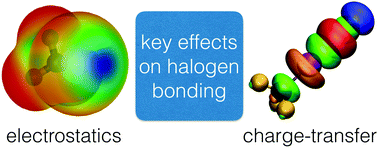Characterizing the interplay of Pauli repulsion, electrostatics, dispersion and charge transfer in halogen bonding with energy decomposition analysis
Abstract
The halogen bond is a class of non-covalent interaction that has attracted considerable attention recently. A widespread theory for describing them is the σ-hole concept, which predicts that the strength of the interaction is proportional to the size of the σ-hole, a region of positive electrostatic potential opposite a σ bond. Previous work shows that in the case of CX3I, with X equal to F, Cl, Br, and I, the σ-hole trend is exactly opposite to the trend in binding energy with common electron pair donors. Using energy decomposition analysis (EDA) applied to a potential energy scan as well as the recent adiabatic EDA technique, we show that the observed trend is a result of charge transfer. Therefore a picture of the halogen bond that excludes charge transfer cannot be complete, and permanent and induced electrostatics do not always provide the dominant stabilizing contributions to halogen bonds. Overall, three universally attractive factors, polarization, dispersion and charge transfer, together with permanent electrostatics, which is usually attractive, drive halogen bonding, against Pauli repulsion.



 Please wait while we load your content...
Please wait while we load your content...